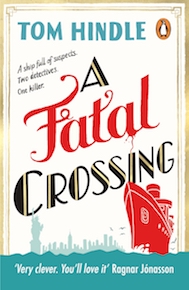We can all get behind a good whodunit. The curious clues, the shifty suspects, the endless twists and turns... More than a hundred years since Agatha Christie published her first Poirot novel, The Mysterious Affair at Styles, the likes of Anthony Horowitz and Lucy Foley are routinely making bestseller lists with modern renditions of the classic murder mystery.
But what is it that’s made the whodunit so enduring? A police procedural will have plenty of clues, just as a thriller will boast its fair share of twists. What is it about a whodunit that lands so differently?
They focus on the mystery rather than the murder
I think we all have a natural – if slightly morbid – fascination with murder. Only look at the popularity of true-crime podcasts, the number of murder-fuelled documentaries regularly making Netflix’s ‘Top 10’, even the way we take crime novels on holiday to read on the beach. There’s no denying, in my mind at least, that we are naturally intrigued by the chilling notion of murder.
Now, a whodunit won’t shy away from the gory details of a crime scene when the occasion calls for it. But what it does give you is a story that focusses more on the mystery than the murder. There’s an emphasis on the human element – the relationships between the characters, the secrets they’re keeping, the lies they’ve told. A terrible crime will always act as the catalyst of the story, but the focus is on drama, rather than blood and gore. And when it comes to investigating the crime, it’s about who these people are, rather than simply who a fingerprint belongs to.
This, for me, is key to the answer of why whodunits are so enduring. They tell a story that is all about murder, but is less functional or analytical and is instead deeply human.
They reveal the darkness beneath the glamour
While a lot of crime stories take us to frightening, dangerous sorts of places, like the seedy underbelly of a grimy city, a whodunit tends to do something different. In my case, the scene of the crime is a glitzy cruise ship. But a whodunit might also take us to a quaint country village, a beautiful wedding, a luxury hotel... What makes these locations so compelling is that, in many cases, they’re the last place in the world you’d expect to be the scene of a brutal murder. It’s fascinating to pull back the curtain and see what darkness lurks beneath.
The murder injects a little chaos. Then, throughout the investigation, we see that glittering façade unravel and transform into something that’s really quite dark. It’s all about contrast – the subversion of our deeply ingrained expectations. A good whodunit should take a place we naturally assume to be safe; maybe even comforting. Then, it should that turn place of safety into the scene of a hideously brutal crime.
It’s a ridiculously flexible genre
As long as it involves a murder, a mystery surrounding how or by whom that murder has been committed, and someone whose mission it is to solve said-mystery, there’s really no limit to where and when a whodunit is set. Japanese mystery, for instance, seem to be particularly popular at the moment.
This flexibility is key. Everything we’ve covered here can be applied just as easily to a remote corner of Japan as it can to the leafy English villages Agatha Christie often chose as her subject, or even the modern mysteries written by the likes of Janice Hallett or Richard Osman. I think that’s ultimately a large part of why whodunits have endured, and why I suspect they will continue to for a long time to come.
It’s like playing a game with the author
For me, this is the answer to what makes a whodunit so enjoyable. It’s the reason it’s so satisfying if you can guess the twist before the big reveal – or, likewise, so frustrating if there’s vital information kept from you until the last minute: We, as readers, like to play detective ourselves.
We like to look for the clues, meet the suspects and see if we can crack the case before the detective in the story. I can’t think of many other genres that do this in quite the same way – give us exactly as much to work with as the hero and almost dare us to see if we can work it out first. A fair, well-structured whodunit is one of the most enjoyable reading experiences in you can have. It’s the reason I love writing in this genre, and ultimately, the reason I think will contribute most to their enduring popularity.
Tom’s debut murder mystery, A Fatal Crossing, is out now in all good bookshops and online. Read SHOTS’ review here.

Penguin
RRP: £8.99
Released: July 28 2022
PBK